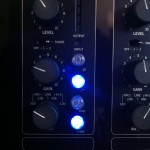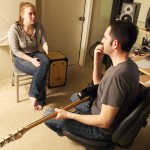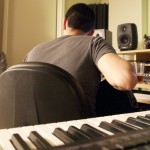If you’re not familiar with Bekah Kelso then you haven’t heard one of the most talented performers(real) around. Take natural talent and drive it with extensive gigging and you get a performer with laser sight acuity. On Bekah’s last recording, “Departures”, I prided the project on the fact that no pitch correction was used. It might seem careless if you believe at least a “safety” tuning pass is the least you can do to a vocal performance. Bends, vibratos, expressive formant tonality, etc. are, to me, what makes a performance. So again we tracked relatively quickly and let the song tell us where to go.
We took that approach further on the 4 out of the 10 possible songs we started with and decided to work on. We had limited time as Bekah was getting ready to make a big move out of Texas to Seattle. We will continue to forge this project through online collaboration and wrap up in May.
First we recorded “demo” takes (Guitar/Vocal/Click) to about 10 ideas Bekah has been looking for the right time and place to bring into this world. We narrowed it down to 4 songs we fastidiously worked, sculpted, rearranged, manipulated and tracked. We started by adding Bass guitar. After the initial “guide” take I decided to lower the click and feel the original acoustic guitar/vocal take. That gave us a fluidity that can easily be lost or edited out of music.We kept throwing around the idea,”This is what we do.” and suddenly most first takes were right where they needed to be. That wasn’t the case for all tracks but it sure made the aggregated tracks jump and move.
I tried to maintain the flow of one song at a time but if at some point the “feeling” was absent we’d listen to another and if that caught our vibe we’d attack and conquer. After the bass was complete we now had a foundation of groove. Bass against guitar. We’d then track “keeper” acoustic takes and replace the guides. There’ was no real plan or list to follow. It was really based on the vibe or feel we were attuned to and inject as much as possible to the recording of the performance. As chaotic as it might seem there was a calmness about what we were doing that led to some magic and confidence in our decisions. Totally worth it.
We then would move on to electric guitars and other instruments.
The Electric guitar was tracked using a Fender Hot Rod Deluxe and a G&L semi-hollow ASAT mic’d with either and AKG C414B or a Samson VR88(same as “Departures”) depending on what the song called for. We layered some percussion tracks also recorded with the 414. by this time the click was muted and they started to feel like complete songs.
We moved on to Vocals using a Neumann TLM 193 through Universal Audio’s 4110. This combo caught the airy, harmonically appealing, breathiness of Bekah’s voice while maintaing a natural tone. On the last day we both decided that one song in particular was not ready for vocals or just wasn’t matching up to the other songs so with ruthless empirical zeal we scrapped it and reworked, arranged and tracked a completely new song. Talk about magic. In a matter of hours 2 counter point Acoustic Guitars, Bass, were ready for final Vocals and with in a few takes the song was now ready to move forward.
We will track drums when all other songs have been pre-produced and rehearsed to the rough mixes. Ryan Kelso will pull drum duties while Marty Barrera will add more percussion. I am excited about the prospects this project holds in store for us. Stay tuned and please check out Bekah Kelso
Photos by Sean-Micheal Argo


